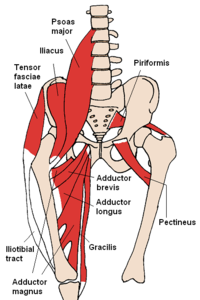
Photo from wikipedia
OBJECTIVE The aims of this study were twofold: firstly, to compare hip abductor muscle volumes in individuals with patellofemoral joint (PFJ) osteoarthritis (PFJ OA) against those of healthy controls; and… Click to show full abstract
OBJECTIVE The aims of this study were twofold: firstly, to compare hip abductor muscle volumes in individuals with patellofemoral joint (PFJ) osteoarthritis (PFJ OA) against those of healthy controls; and secondly, to determine whether hip muscle volumes and hip kinematics during walking are related in individuals with PFJ OA and healthy controls. METHODS Fifty-one individuals with PFJ OA and thirteen asymptomatic, age-matched healthy controls ≥40 years were recruited. Volumes of the gluteus medius, gluteus minimus and tensor fasciae latae were obtained from magnetic resonance (MR) images. Video motion capture was used to measure three-dimensional hip joint kinematics during overground walking. RESULTS Significantly smaller gluteus medius (P = 0.017), gluteus minimus (P = 0.001) and tensor fasciae latae (P = 0.027) muscle volumes were observed in PFJ OA participants compared to controls. Weak correlations were observed between smaller gluteus minimus volume and larger hip flexion angle at contralateral heel strike (CHS) (r = -0.279, P = 0.038) as well as between smaller gluteus minimus volume and increased hip adduction angle at CHS (r = -0.286, P = 0.046). CONCLUSION Reduced hip abductor muscle volume is a feature of PFJ OA and is associated with increased hip flexion and adduction angles during the late stance phase of walking for PFJ OA participants and healthy controls.
Journal Title: Osteoarthritis and cartilage
Year Published: 2019
Link to full text (if available)
Share on Social Media: Sign Up to like & get
recommendations!